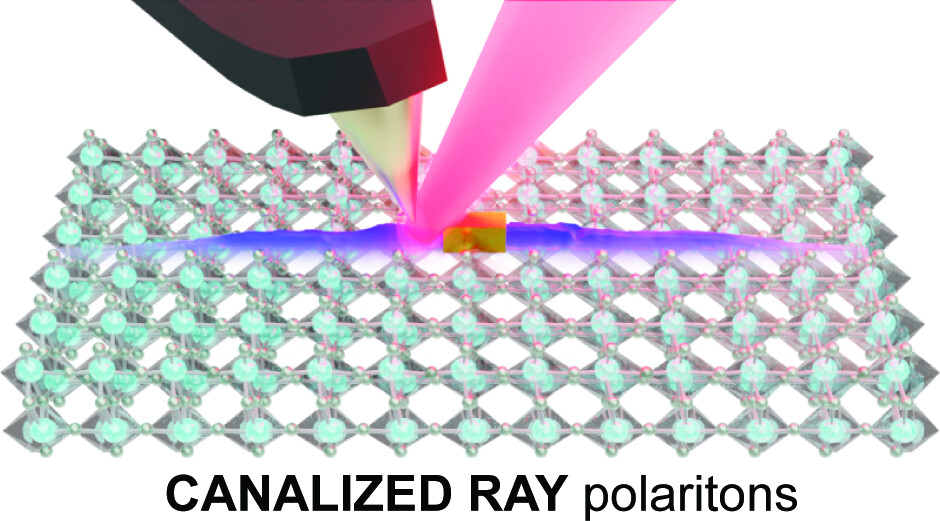Polariton loss-induced canalization in thin slabs
In the world of nanophotonics, the ability to control light with precision at the nanoscale is a game-changing goal. Recent advancements in materials science have opened up new pathways for achieving this, particularly through the use of van der Waals (vdW) crystals. These ultra-thin materials, composed of layers of atoms held together by weak van der Waals forces, have introduced new types of light-matter interactions, leading to the development of innovative technologies.
Among these interactions, a phenomenon known as polariton canalization is gaining attention. Polaritons are quasiparticles resulting from the coupling of photons with other excitations, such as lattice vibrations (phonons). In certain vdW materials like α-MoO3 (molybdenum trioxide), polaritons exhibit unique behaviours, including strongly directional, ray-like propagation at the nanoscale. These behaviours hold promise for revolutionizing integrated nanophotonic devices, molecular sensing, and thermal transport systems. In this article, we’ll explore the cutting-edge discovery of loss-induced canalization in polaritons and its implications for nanophotonics.

Understanding Polaritons in vdW Crystals
Phonon polaritons (PhPs) are a specific type of polariton that emerge when photons couple with lattice vibrations in polar crystals. In biaxial vdW crystals like α-MoO3, these polaritons exhibit hyperbolic propagation, a unique feature arising from the material’s anisotropic dielectric properties. This means that the propagation of polaritons is confined to specific angular sectors within the crystal plane, leading to highly directional energy transport.
When vdW materials are stacked or twisted, an exotic behaviour called canalization can occur. In canalization, polaritons propagate along a single in-plane direction with a constant phase, resembling a tightly collimated ray of light. Traditionally, achieving canalization required complex fabrication processes, such as stacking and twisting vdW layers. However, researchers are now discovering simpler methods to induce canalization, such as substrate engineering or leveraging material losses.
The Breakthrough: Loss-Induced Canalization
A recent study introduces 1 a novel type of polariton canalization driven by optical losses within a single thin slab of α-MoO3. Loss-induced canalization is a counterintuitive phenomenon that occurs when the material’s dielectric permittivity satisfies specific conditions, namely when the modulus of the permittivity (|ε|) approaches infinity. This results in the collimation of polaritons along crystalline directions with high optical losses, a stark contrast to traditional approaches where losses are minimized.
To investigate this, researchers conducted numerical simulations on a hypothetical material with varying dielectric permittivity. They found that as the imaginary part of the permittivity along one direction increased, the propagation of polaritons transitioned from hyperbolic to highly collimated, with energy confined to a narrow angular range. This phenomenon was further enhanced by pairing the material with a substrate like SiO2, which has moderate negative permittivity in the mid-infrared range.
Experimental Validation: A Single-Slab Platform
To bring theory into reality, researchers used a thin slab of α-MoO3 on a SiO2 substrate and employed scattering-type scanning near-field optical microscopy (s-SNOM) to visualize the polariton propagation. At specific mid-infrared frequencies, they observed a striking transformation:
- At higher frequencies, polaritons exhibited hyperbolic wavefronts with angular spreading.
- As the frequency approached the transverse optical (TO) phonon resonance of α-MoO3, the polaritons became collimated along a single in-plane direction with a constant phase.
- At even lower frequencies, hyperbolic behaviour re-emerged, confirming the frequency-dependent nature of canalization.
These observations matched the predictions from numerical simulations, providing robust experimental evidence of loss-induced canalization in a single thin slab.
Why It Matters: Applications and Implications
The ability to achieve polariton canalization in a simple, unstructured material platform like α-MoO3 opens up exciting possibilities for nanophotonics. Some potential applications include:
- Integrated Nanophotonic Circuits: The constant-phase, directional propagation of polaritons can enable compact and highly efficient on-chip light-based devices.
- Molecular Sensing: Canalized polaritons can interact strongly with molecules, enhancing the sensitivity of spectroscopic techniques.
- Thermal Management: The controlled propagation of energy at the nanoscale could lead to advanced heat transport systems.
- Strong Light-Matter Interactions: The unique characteristics of ray-like polaritons provide opportunities for exploring new regimes of quantum optics.
Moreover, the simplicity of the platform—a single thin slab on a standard substrate—makes it highly accessible for practical implementation. This could accelerate the integration of polaritonic devices into existing technologies, bridging the gap between fundamental research and real-world applications.
Looking Ahead
The discovery of loss-induced canalization in single slabs of α-MoO3 represents a significant step forward in the quest to control light at the nanoscale. By leveraging the natural anisotropy and loss characteristics of vdW materials, researchers have demonstrated a new way to achieve precise and directional energy transport without the need for complex fabrication techniques. As this field advances, we can expect further innovations that will reshape the landscape of nanophotonics, bringing us closer to a future where light manipulation at the atomic scale becomes routine.
Author: César Tomé López is a science writer and the editor of Mapping Ignorance
Disclaimer: Parts of this article may have been copied verbatim or almost verbatim from the referenced research paper/s.
References
- Enrique Terán-García, Christian Lanza, Kirill Voronin, Javier Martín-Sánchez, Alexey Y. Nikitin, Aitana Tarazaga Martín-Luengo, and Pablo Alonso-González (2025) Real-Space Visualization of Canalized Ray Polaritons in a Single Van der Waals Thin Slab Nano Letters doi: 10.1021/acs.nanolett.4c05277 ↩